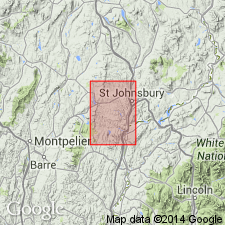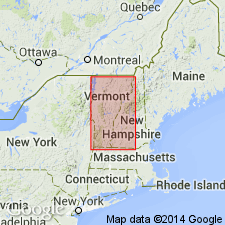
- Usage in publication:
-
- Crow Hill member
- Modifications:
-
- Named
- Dominant lithology:
-
- Quartzite
- Schist
- AAPG geologic province:
-
- New England province
Summary:
Named the Crow Hill member of the Waits River formation for Crow Hill, near village of St. Johnsbury, northeastern VT. Consists of a series of interbedded quartzites, micaceous quartzites, gray quartz-mica schists, quartz-feldspar granulites, and minor calcareous rocks distinct from the typical Waits River. Member closely resembles the Gile Mountain formation and may be continuous with it, but continuity cannot be proved due to lack of outcrops. The Crow Hill is of Silurian and (or) Devonian age.
Source: GNU records (USGS DDS-6; Reston GNULEX).

- Usage in publication:
-
- Crow Hill member
- Modifications:
-
- Age modified
- AAPG geologic province:
-
- New England province
Summary:
The Crow Hill member of the Waits River formation is changed from Silurian and (or) Devonian age to Early Devonian age. Unit consists of tough gray quartzite.
Source: GNU records (USGS DDS-6; Reston GNULEX).
For more information, please contact Nancy Stamm, Geologic Names Committee Secretary.
Asterisk (*) indicates published by U.S. Geological Survey authors.
"No current usage" (†) implies that a name has been abandoned or has fallen into disuse. Former usage and, if known, replacement name given in parentheses ( ).
Slash (/) indicates name conflicts with nomenclatural guidelines (CSN, 1933; ACSN, 1961, 1970; NACSN, 1983, 2005, 2021). May be explained within brackets ([ ]).

